Single-Ended Universal 20W type
Audio Output Transformer
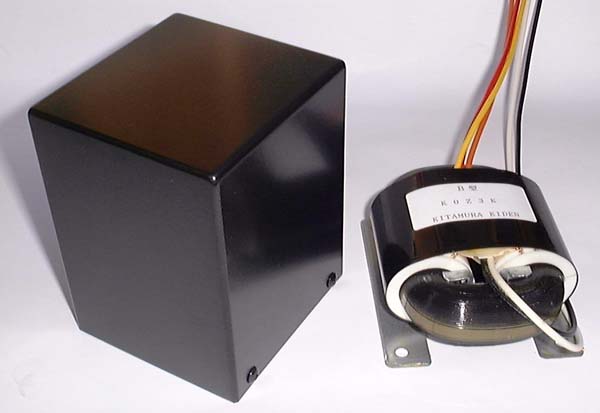

The right on the photo is the R core output transformer in bare condition. The product is enclosed in the square case on the left.
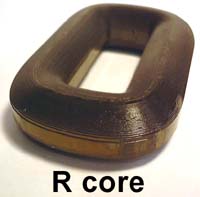
R core power transformers are now increasingly introduced for the high-end
HiFi components because of its excellent technical advantages. R core is
of non-cut construction and has excellent magnetic properties. The magnetic
core used for audio output transformer has evolved from EI core, cut core,
and to toroidal core achieving successful results to improve the performance
of the transformer. R core has several advantages over toroidal core that
has been evaluated as the best. In fact, R core enables further technical
improvements of the audio output transformer. We have designed this R core
audio output transformer and carried out the performance tests for final
product. The product packaging is made by Kitamura Kiden Co., Ltd., an
originator of the R core transformer.
For single-ended audio transformer, a gap is provided by cutting the core.
This is for preventing the core from being magnetically saturated by superimposed
DC current. A well-designed gap brings a constant inductance characteristic
to the output transformer, an even level of inductance independent from
the various levels of superimposed DC current or of the input signal, achieving
the result that an audio output transformer has stable characteristics
and good sound quality. Since R core has a good magnetic properties and
excellent constant inductance characteristic, we are successful in introducing
excellent audio output transformer for single-ended amplifier.
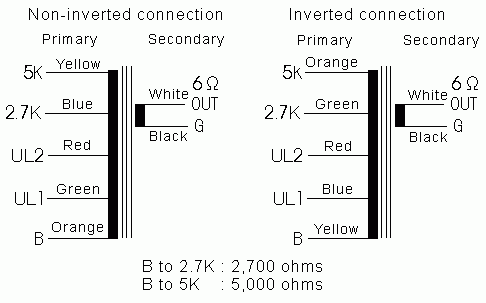
| Type | for Single-Ended |
| Output capacity | 20W/50Hz |
| Primary impedance | 2,700 ohms, 5,000 ohms, with UL tap |
| Secondary impedance | 6 ohms |
| Frequency bandwidth | 40hz to 40Khz (-2dB), input=4V, signal source impedance=5,000 ohms |
| Primary inductance (H) | 12H(min.), 13H(max.) (5,000 ohms, DC current 80mA) 7H(min.), 7.5H(max.) (2,700 ohms, DC current 80mA) |
| Primary permissible DC current | 100mA (5,000 ohms), 120mA (2,700 ohms) |
| Recommended primary DC current | 60mA or below (5,000 ohms), 80mA or below (2,700 ohms) |
| Power loss | 0.33db |
| Dielectric withstanding voltage between primary and secondary | 2KVAC |
| Maximum permissible voltage of primary P-P | 1KVAC |
| Core | Type R50 50W core |
| Shape | Enclosed in square case, the same mounting dimensions as those of Tango FW-20 and XE-20 |
| Connections | Lead wires |
| Overall dimensions and weight | W: 83mm, D: 78mm, H: 107mm, Wt.: 1.5Kg W: 3.27inch, D: 3.07inch, H: 4.21inch, Wt.: 3.3lbs. |
| Price | US$120(excluding tax and shipping) |
The table below describes the selection of load impedance and the relation of the phase between the primary and secondary. You can select non-inverted connection between the primary and secondary for two-stage amplifier and inverted connection for three-stage amplifier. When the load is selected to 5,000 ohms, two taps for UL are available; its feedback ratio is 50% or 25%. The higher ratio makes the plate resistance and distortion factor lower, however, the sensibility and output power will be reduced.
| Connected to | Non-inverted 5,000 ohms | Non-inverted 2,700 ohms | Inverted 5,000 ohms | Inverted 2,700 ohms |
| Plate | Yellow | Blue | Orange | Green |
| Screen grid (UL tap ratio) | Red (50%) Green (25%) |
Green (33%) | Red (50%) Blue (25%) |
|
| Power source | Orange | Orange | Yellow | Yellow |
The two main features are the wide bandwidth 40hz to 40Khz (-2db) and plain attenuation characteristic without any peculiar peaks and dips at the high frequency. The impedance characteristic is as well plain and quite similar to the frequency characteristic. The flat section of the impedance on the graph reads 4,800 ohms, a little bit smaller value than the nominal specifications.
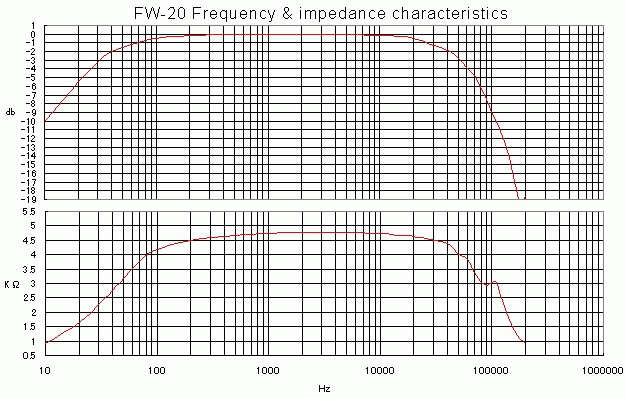
The frequency characteristic of the audio output transformer varies with the magnitude of the input signal and with the signal source impedance that drives the transformer
The graph below shows the frequency response of the output transformer driven by the signal source impedance=5,000 ohms, which represents the case that the transformer is driven by beam or pentode power tubes having relatively high plate resistance. It features a wide bandwidth 40hz to 40Khz (-2dB) and plain attenuation characteristic at the high frequency without any peculiar peaks and dips. Compared to the push-pull transformer RX-40-5, the low frequency at very small signal level (0.4V) drops to a certain extent. High frequency attenuates in a plain manner, presenting a characteristic very suitable for NFB operation.
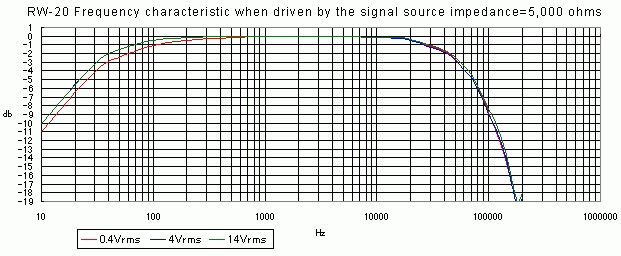
This represents the case that the transformer is driven by such as triode power tubes having relatively low plate resistance. The bandwidth further extends compared to the above case with the signal source impedance=5,000 ohms and the frequency response expands to 15hz (-2dB) at the low end and to 85Khz (-2dB) at the high end with every signal level. You will have an excellent result by the combination of RW-20 and 300B or 2A3.
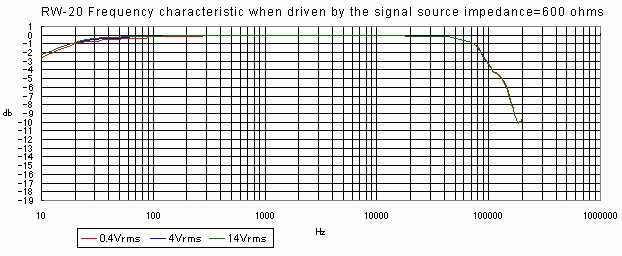
The primary inductance of the single-ended output transformer has a characteristic of constant inductance. With this, the output transformer can drive steadily the loudspeaker without being influenced by the level difference of the superimposed DC current or AC input signal. The less the inductance fluctuates under various conditions, the more solid and stable sound quality can be obtained.
When designing RW-20, we attached greater importance to the constant inductance
characteristic obtained from the excellent performance of R core. For this
purpose, we have kept ourselves modest for the low frequency service limit.
The primary inductance of RW-20 has an excellent constant inductance characteristic,
12H at minimum and 13H at maximum (5,000 ohms, superimposed DC current
80mA). The fluctuation of the inductance has been kept minimum. The graphs
below show the inductance of the load 5,000 ohms and 2,700 ohms. You will
notice its excellent constant characteristic. The inductance remains unchanged
quite independent from the various levels of signal and DC current unless
the core is saturated.
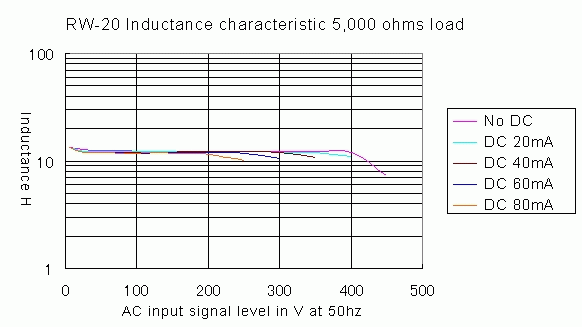
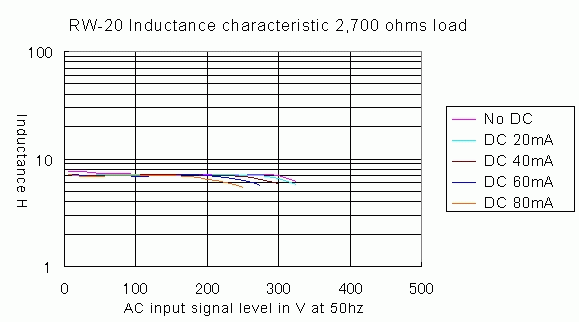
We have installed RW-20 on our 300B single-ended power amplifier and carried out the measurements. Since this is a test amplifier, the output transformers are not enclosed in case and unconnected lead wires are untouched for future tests.
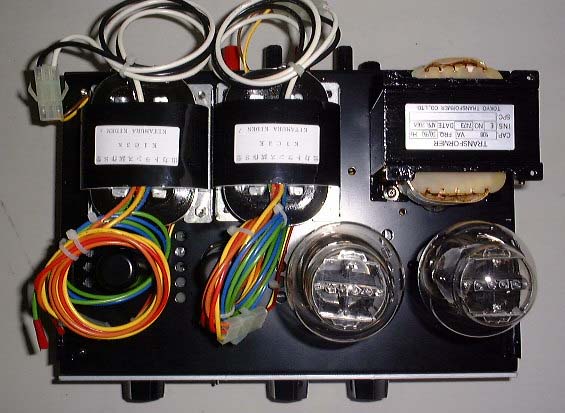
The low frequency extends down to 15hz (-3dB) within 1W output. At 6W, the frequency response below 30Hz attenuates because of the core saturation. Since the maximum permissible output is proportional to the square of the frequency ratio, the permissible output of RW-20 is 20W at 50hz that is exactly the design value, and then 7W at 30hz, 5W at 25hz, and 3W at 20hz. The high frequency extends up to 75Khz (-3dB), quite a good figure. The high frequency attenuation curve is very plain except small peak at 200Khz.
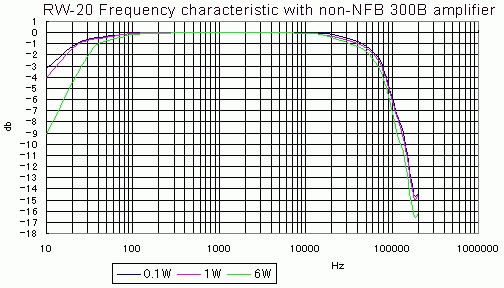
The curves below represent a total distortion factor of the 300B amplifier and not only that of the output transformer itself. The distortion of 1Khz and 10Khz are low and remain at a quite same level. The curves are very simple. The distortion of 100hz is a little bit worse than that of 1Khz, however, this is an average performance as a middle size 20W single-ended output transformer.
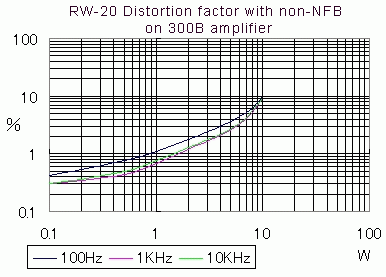
The graph below shows the frequency characteristic with NFB=3dB. At 1W output, the bandwidth is improved to 12hz to 85Khz (-3dB). At 6W output, the saturated core makes attenuate the response of low frequency below 30hz, nearly same characteristic as of non-NFB. The high frequency goes on excellently and attenuates in a plain manner.
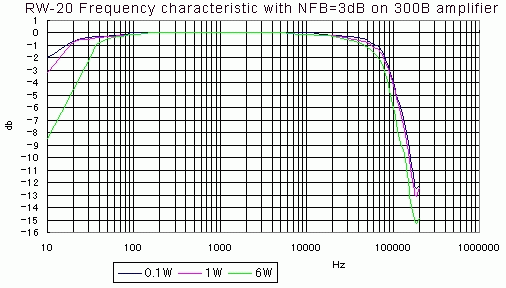
The graph below shows the distortion factor with NFB=3dB. You will notice very low distortion factors at 1Khz and 10Khz. At 100hz, the distortion is not so good as those of 1Khz and 10Khz; however, this is enough a low level as single-ended amplifier.
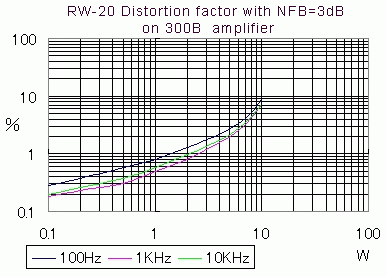
The primary coil of RW-20 is perfectly symmetrical the center of which is set at red lead wire. This construction enables RW-20 to be used as constant inductance type push-pull output transformer, fairly suitable to build a DC unbalance current proof, maintenance-free type push-pull amplifier. The table below describes the connections and specifications as constant inductance type push-pull output transformer.
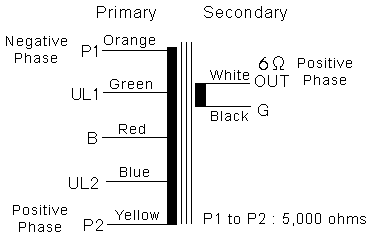
| Type | for constant inductance type Push-Pull |
| Output capacity | 20W/40hz |
| Primary impedance | 5,000 ohms, with UL (50%) taps |
| Secondary impedance | 6 ohms |
| Frequency bandwidth | 40hz to 95Khz (-2dB), input=4V, signal source impedance=5,000 ohms |
| Primary inductance (H) | 12H(min.), 13H(max.) |
| Primary permissible DC current | 180mA (for 2 tubes) |
| Primary permissible unbalance DC current | 60mA (recommended 40mA or below) |
| Power loss (6 ohms load) | 0.33db |
| Dielectric withstanding voltage between primary and secondary | 2KV AC |
| Maximum permissible voltage of primary P-P | 1KV AC |
| Core | Type R50 50W core |
| Shape | Enclosed in square case, the same mounting dimensions as those of Tango FX-40 |
| Connections | Lead wires |
The two main features are wide bandwidth 40hz to 95Khz (-2dB) and plain attenuation characteristic at high frequency without any peculiar peaks and dips. The low frequency response is the same as that of single-ended connection, clearly worse than that of RX-40-5, an exclusive push-pull output transformer. High frequency response is improved to 95Khz (-2dB) compared to the single-ended connection. This is because such push-pull connection of the transformer is equal to parallel drive of 1,250 ohms transformers since the center of the primary coil (red lead wire) is connected to the common source. The high frequency attenuates in a very plain manner, quite suitable for NFB operation.
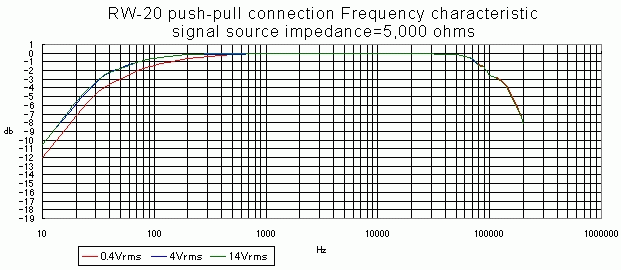
The impedance and inductance characteristics are the same as those of the single-ended connections. Please refer to those characteristics.